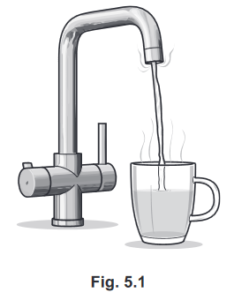Question:
Fig. 5.1 shows a kitchen tap that supplies instant boiling water.

Cold water passes over an electric immersion heater inside the tap.
The boiling point of water is 100 °C.
(a) State what is meant by boiling point.
Answer/Explanation
Ans: temperature
at which liquid becomes a gas or liquid and gas exist together
(b) The immersion heater is powered by the mains at a voltage of 230 V. When the tap is opened, the heater switches on and the current in the heater is 13 A.
(i) Calculate the thermal energy produced by the heater in 60 s.
thermal energy = …………………………………………………
Answer/Explanation
Ans: 1.8 × 10 5 J
(E =) VIt (in any form) or 230 × 13 × 60 or 230 × 13 or 3000
(ii) The specific heat capacity of water is 4200 J / (kg °C). The cold water that enters the tap is at 22 °C.
Calculate the rate at which water at its boiling point emerges from the tap.
rate = …………………………………………………
Answer/Explanation
Ans: 9.1 × 10 –3 kg / s 9.1 × 10 –3 kg / s
(ΔT =) 100 – 22 or 78 or (ΔT =) 100 – 22 or 78
m = E / cΔT (in any form) or 1.8 × 105 / (4200 × 78) or (rate =) P / cΔT (in any form) or m = E / cΔT and E = Pt
1.8 × 10 5 / (4200 × 78 × 60) or or 3000 / (4200 × 78)
5.5 × 10N or 9.1/9.2 × 10N or 230 × 13 / (4200 × 78)
or 9.1 / 9.2 × 10 N
(c) The metal tap is earthed and there is a fuse in the cable that connects the heater to the mains.
1. Explain how the earth wire protects the user.
Answer/Explanation
Ans: if the tap becomes live or if the (live) cable touches the (metal) tap
there is a current to earth / in the earth wire (which blows the fuse)
2. Explain how the fuse protects the circuit.
Answer/Explanation
Ans: the current (in earth wire) is large and fuse melts / blows / stops current / breaks circuit
Question
Water has a specific heat capacity of 4200 J / (kg °C) and a boiling point of 100 °C.
(a) State what is meant by boiling point.
(b) A mass of 0.30 kg of water at its boiling point is poured into a copper container which is initially at 11 °C. After a few seconds, the temperature of the container and the water are both 95 °C.
(i) Calculate the energy transferred from the water.
energy transferred =
(ii) Calculate the thermal capacity of the copper container.
thermal capacity of the copper container =
(iii) Water from the container evaporates and the temperature of the remaining water decreases slowly.
Explain, in terms of molecules, why evaporation causes the temperature of the remaining water to decrease.
Answer/Explanation
Answer:
(a) temperature at which liquid turns into gas
(b) (i) (E =) mcΔT OR 0.30 × 4200 × (100 – 95)
6300 J
(b) (ii) (C =) E / ΔT OR 6300 / 84
75 J / °C
(b) (ii)molecules do work against attractive force as they evaporate
more energetic molecules more likely to escape
average energy of remaining molecules decreases
Question:
During a picnic on a warm, dry day, a metal can of lemonade is wrapped in a damp cloth.
Evaporation cools the water in the cloth.
(a) Explain, in terms of molecules, how evaporation cools the water in the cloth.
Answer/Explanation
Ans: ast(er) / high(er) speed / (more) energetic molecules escape (into air)
average speed / average kinetic energy of molecules decreases
temperature related to speed / energy of molecules or slow(er) / low(er) speed / less energetic molecules remain (in water)
(b) As the water in the cloth cools, so does the lemonade.
Explain how electrons transfer thermal energy through the metal of the can.
Answer/Explanation
Ans: any three from:
atoms / ions vibrate
(vibrating) atoms / ions hit electrons
electrons propelled / travelling through metal / moving through metal
electrons hit (distant) atoms
free electrons / delocalised electrons mentioned
Question
Liquids and gases are two states of matter.
(a) In both boiling and evaporation, a liquid changes into a gas.
(i) State two ways in which boiling differs from evaporation.
1.
2.
(ii) Before injecting a patient, a doctor wipes a small amount of a volatile liquid on to the patient’s skin.
Explain, in terms of molecules, how this procedure cools the patient’s skin.
(b) Gases can be compressed but liquids are incompressible.
Explain, in terms of molecules, why liquids are incompressible.
Answer/Explanation
Answer:
(a) (i) any two from:
occurs throughout the liquid OR bubbles formed
occurs at one temperature / boiling point
does not produce cooling OR unaffected by draught / surface area / humidity
(ii) (more) energetic molecules escape (from the liquid) OR molecules gain energy and escape OR molecules
overcome intermolecular forces / break bonds
average speed decreases OR molecules with less (kinetic) energy left behind
temperature of liquid decreases
(thermal) energy conducted / gained from skin / body OR (thermal) energy lost by skin / body
(b) molecules touching OR no space between molecules
large (repulsive / intermolecular) forces (when moved closer)
